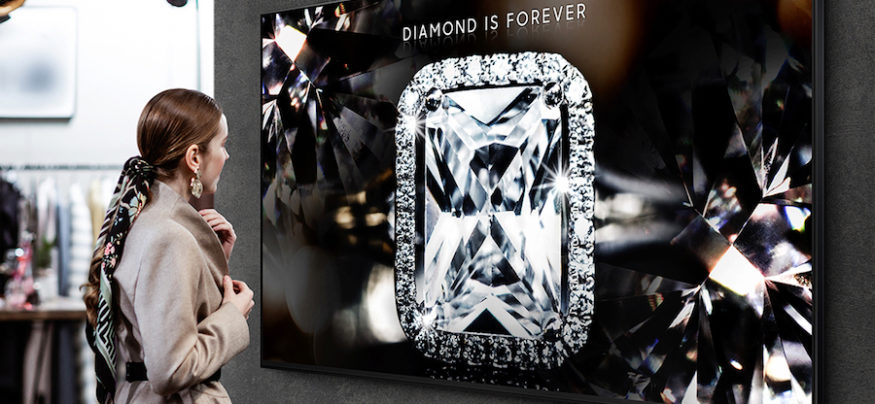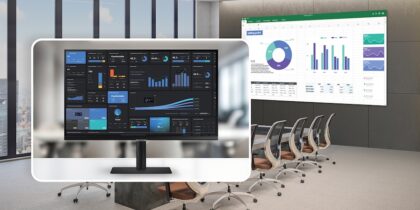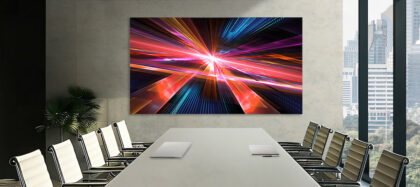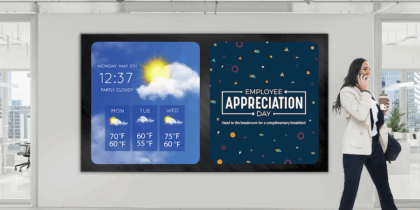When anyone from fashion designers to engineers and architects talks about quality, they invariably refer to the attention to detail necessary to achieve peak performance and visual beauty. With 8K displays, it’s all about that detail.
It was a revelation for TV viewers and digital signage users when the display business advanced from standard to high definition (HD) resolution. Soft visuals grew sharper. We started to see and appreciate detail.
It happened again when the display business advanced from full HD to 4K: even more detail.
And now the display industry is evolving to 8K — packing so many pixels into every inch of a display that the visuals on a screen look as crisp and vibrant as gallery-quality photography.
Next-Generation Resolution
Explained simply, 8K displays have dimensions of 7,680 pixels wide by 4,320 pixels tall. That results in a resolution with four times the pixel density of 4K displays.
Samsung’s new 82-in. QLED 8K commercial display has 33 million pixels. It’s so many pixels packed into a screen that materials produced to that resolution — still images, motion graphics and video — are considered “hyperreal” — more realistic than in real life.
Along with pixel density, QLED technology makes 8K screens remarkably vibrant, delivering 100 percent of the available range of colors. That happens because of a layer added to the stack (or sandwich) of layers that make up a commercial display. An enhancement film uses quantum dots nanoparticles (the “Q” in “QLED”) to tune and amplify color output.
Your Ultimate Videowall Guide
Learn how to build the optimal video wall for your business. Download Now
The results on a large-format LCD display are sumptuous, bright and stunning. But as 8K display technology has progressed from prototypes to commercial production, one question tends to come up: Is 8K necessary?
The answer is yes — particularly in well-defined use cases.
Putting 8K to Work
Custom and specialized content comes with unique display needs. There are plenty of business applications where more pixels provide greater value.
Retail and Brand Advertising
Premium products are marketed and sold primarily based on quality materials and attention to detail. Where fashion clothing and accessories are sold on price and promotions, luxury goods like handbags, shoes, timepieces and jewelry are all about the details. An 8K screen delivers every sparkle of a gem.
Medicine and Research
Medical imaging is, by necessity, about details. Radiologists and other specialists have long used medical-specified desktop displays that deliver very high resolutions. The emerging breed of 8K displays means that high-detail imaging for material such as MRI scans can be viewed on much larger screens, and seen and discussed by teams.
The larger canvas allows a specialist to easily view multiple images, to do things like pre- and post-treatment comparisons. Outside treatment areas, organizations such as research centers and pharmaceutical manufacturers can use the high-density pixels in public areas — like waiting rooms and lobbies — to celebrate discoveries and advances.
Exploration and Operations
Energy and mining companies rely heavily on tools like satellite and seismic imaging for decision making. For natural gas, as an example, seismic imaging provides a high-resolution view below the sea and ground to show where there may be hydrocarbon reservoirs. High detail images are best seen and reviewed on large screens that deliver full, highly accurate colors. For industrial operators, 8K display canvases are ideally suited to applications such as control rooms that have one or many screens visualizing the data from running systems, and from ongoing feeds such as live cameras.
Making Visuals Pop
Size matters when it comes to 8K. On a small monitor, which demands up-close viewing, our eyes would typically not be able to see all those packed pixels. But on larger displays, all those pixels make visuals pop in the imagery.
Future-proofing by investing in 8K now makes sense in certain use cases, and Samsung has developed AI-driven technology that can take existing 4K material and upscale the visuals to lifelike 8K. A processor built into the new 8K displays uses machine learning to compare data from millions of images to reduce noise and refine details, like sharpening the edges on text. The result is crisp detail. This means more content production at lower costs, displayed in 8K quality.
The 8K series is also supported by System-on-Chip (SoC) technology with high brightness and pivot design to give enhanced flexibility.
High dynamic range (HDR) technology also boosts visuals, on 4K and the newest 8K screens. HDR is also all about detail — revealing the finer components in the brightest and darkest elements of an image or video that are lost when shown on non-HDR screens. You know that moody, atmospheric drama you watched, when you squinted to see what was going on? With HDR, you’d see it all.
Not for All, for Now
When 4K first emerged, naysayers suggested the screens offered more resolution than most users needed — whether they were consumers or businesses. Now 4K dominates shipments of larger-sized LCD displays, both commercial and consumer.
That happened because content started to advance, and manufacturing volumes reduced prices. The technology went from a premium option to a conventional one. The same will likely happen over time with 8K.
It’s a gamechanger for a few reasons: quadrupled resolution, AI-based upscaling and rich, full HDR color. What do those have in common? Detail.
Download this free white paper to find the signage deployment that works best for your business. For a leading example, take a look at Microsoft’s digital display program in their forward-thinking Netherlands office.









